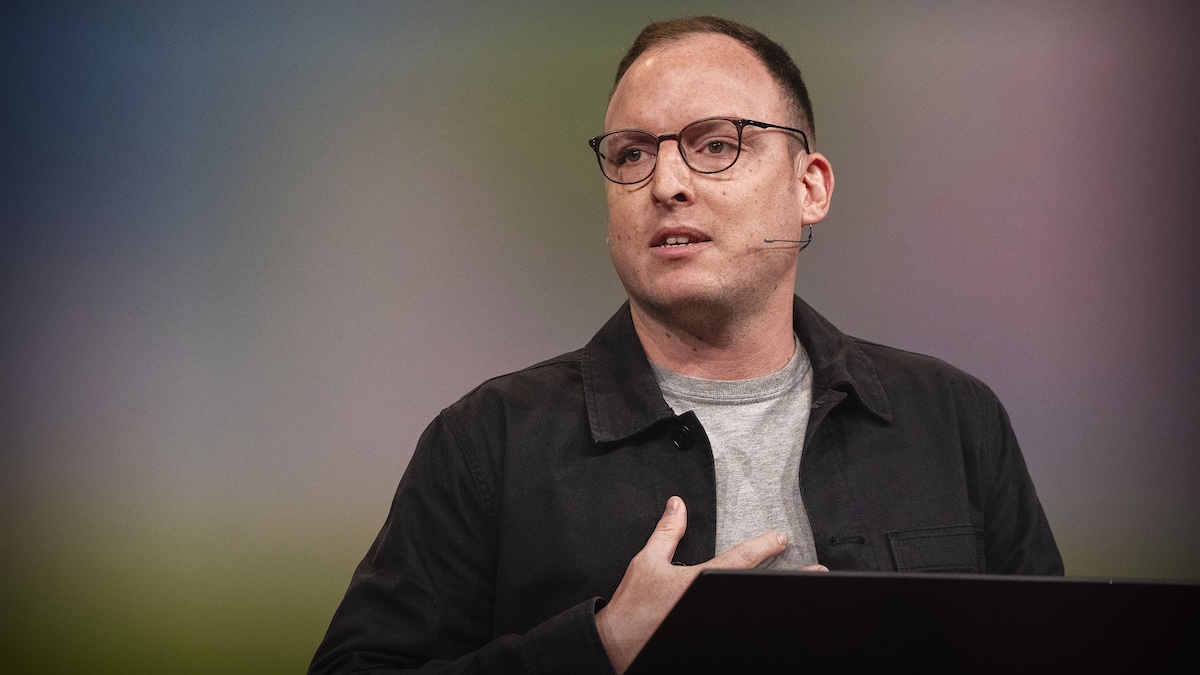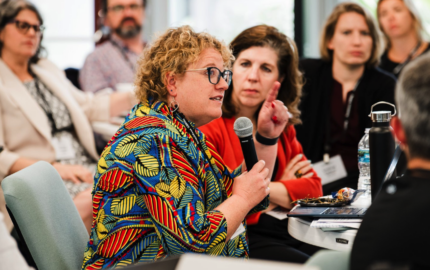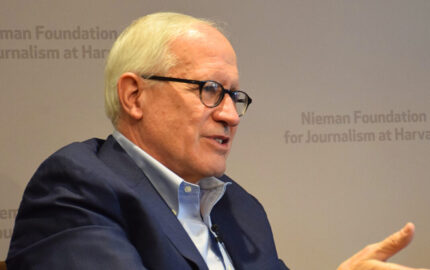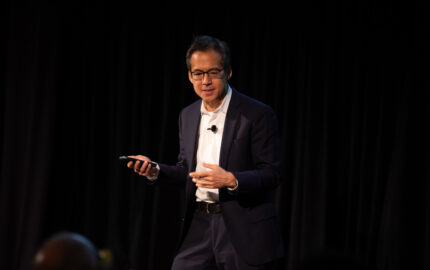Isaac Saul grew up in Bucks County, Pennsylvania — a bellwether county in a swing state where politics was part of daily life. Surrounded by friends and family with a wide range of political views, Saul developed an early appreciation for ideological diversity.
As he began his career in journalism, he noticed that conservative and moderate voters weren’t well represented in mainstream media coverage. Frustrated by the country’s increasing political polarization, Saul launched Tangle News in 2019, a daily newsletter designed to get Americans “out of their political bubbles.”
Tangle is an independent, non-partisan, and subscriber-supported media organization that covers the biggest political stories of the day by summarizing arguments from the right, left, and center — followed by a candid “My take” from Saul or a member of his team. Today, Tangle reaches over 300,000 readers in more than 55 countries.
Speaking with the 2025 class of Nieman Fellows, Saul discussed why transparency matters more than neutrality, how word choice can make-or-break trust with readers, and what it takes to build a newsroom that has genuine ideological diversity. Edited excerpts:
I view the “My take” section as an act of transparency. Readers tend to respond pretty well to that. I also have a little section right above the “My take,” which is just [a disclaimer that] I’m not trying to say what is or isn’t true. It’s one opinion in a newsletter that’s sharing seven different writers’ opinions, and it should be viewed as that, a kaleidoscope and collage of American viewpoints.
I actually think now, six years later, that the “My take” section has been really key to the success, because it adds a human element and personalizes the newsletter. There are others who have done similar things — you can go to allsides.com and see a left-right comparison article, but that’s the whole newsletter, and it feels impersonal, it’s just aggregation — but [when] there’s like a person to direct your emotions to when you’re reading [our] newsletter, it creates this relationship, especially in the newsletter space, that I think is really powerful. Editorially, it gives us an opportunity to say, “This is an inconsistent argument,” or “This is like a dishonest framing of certain data, which all these pundits and stuff that we cite are frequently doing,” and that adds some clarity to the noise. That’s why they’re coming to us. The news can feel really overwhelming, and they want somebody to add some clarity, and so that section is a straightforward way for us to do that.
There are two ways to inoculate ourselves from the kind of “whataboutism” trap. The tariffs thing is actually a great example. When we covered the tariff story, we shared three arguments from the left [and] three arguments from the right … We like to highlight when there’s a breadth of opinion.
The second thing is just the “My take” section again, this is where it’s useful. I think I’ve built up a lot of good will and trust with my readers. Probably 25% to 30% of our readership self-identifies as really conservative — it was 40% until we got a big story done about us in [the public radio program] “This American Life,” which brought in a lot of left-leaning readers — but I think [our conservative audience is] a lot more likely to maybe consider my opinion and be open-minded to my perspective than they are from [New York Times opinion columnist] Thomas Friedman, who’s just going to criticize everything the Trump administration is doing. So it’s helpful to have that section and to have a longer track record where they see that I’m pretty politically moderate and land on different sides of different issues. But it is a big challenge. There’s no doubt that people are operating in totally different realities, and sometimes there are positions that are really mainstream, that I find idiotic or boring. But I don’t view myself as the arbiter of truth or reality. So if 80% of Republicans believe something, and that’s being really widely represented in a lot of opinion pieces and stuff, then, we’re going to share that view, and I can use the “My take” section to address it if I feel like it’s necessary.
In the introductory section of the newsletter, we [found] that people were unsubscribing and saying they stopped reading because of certain language choices that were made there. [For example] readers wrote in, saying they were upset that we used the term “marijuana” instead of “cannabis.” We had this realization [when] our readership was growing, we had to find a way to make more neutral language choices.
We had massive, continuous debate internally and in editorial meetings where we looked at … recommendations on how to navigate this. We considered reader feedback and compared [news outlets’ coverage]. [We discussed] what felt like obscuring the truth, and what felt decent and respectful. There were many difficult decisions — do you call an unborn child a “fetus” or an “unborn child”?
It would be unsurprising to all of you that Fox News doesn’t [use the term] “undocumented immigrants.” They call them “illegal aliens.” I agree with a lot of liberal critics that that’s a dehumanizing term. But I also heard a lot of conservatives who make the case that “undocumented immigrant” obscures the fact that this person came to the country illegally.
We were searching for a solution. Could we appease both [sides] while also being really honest about the issue we’re addressing? In trying to do this, I found “unauthorized migrant” was a term that was sometimes used in government documents. It felt really neutral to me … We started introducing this term that could replace either “illegal alien” or “undocumented immigrant.” And I’m not exaggerating when I say that [since] we made this change a year and a half ago, I’ve gotten literally zero emails about our language choices around discussing illegal immigration and these issues.
We sent a newsletter about [our] editorial guidelines … to explain, as a team, how we came to these decisions [on word choices] from immigration to abortion to race issues to trans issues. Our readership responded really positively. People said, “I don’t agree with every choice you guys made, but it’s really helpful for me to see why you made them.”
When interns come through Tangle, I’ve encouraged them to participate in editing [and] stress-testing arguments that I’m presenting in the newsletter. When you work with somebody like that, it becomes pretty obvious quickly where people are coming from. I’m not going around asking people who they voted for, but we do editorial tests and things like that. And for me at least, it’s not typically hard to tell sort of where people are coming out on certain issues.
To answer the second part of your question, one of the first interns I ever had at Tangle is a woman who now works for us as an editor. When I first had her as an intern, she was a [student.] She grew up in Lynchburg, Tennessee, and she was a pro-life, conservative, religious woman from rural Tennessee going to college at Harvard. When Roe v. Wade was struck down by the Supreme Court, we published some of our early pieces on [the subject.] She was editing the newsletter, and she would highlight stuff and say, “This argument’s weak. Here’s why,” or, “I know what you’re trying to say, but a lot of our conservative readers are going to read it this way.” She wasn’t changing the essence of any of my arguments. She actually made it so that I could make my argument more compelling to people like her. She straight-up strengthened the writing — and this was like a college student who had never worked in media before — she was a really smart young woman who had convictions on a specific issue, and it was really illuminating for me. [I realized] I had so many blind spots on this particular issue. If we had not had her on the team, the stuff that we published would have been way less informative and way less interesting. That is just a great example of how the ideological diversity on staff really improves the product.
First of all, I’m in a very uniquely advantageous position, to create a news platform from scratch which started as a personal endeavor. I can [make] personal decisions that allow [my platform to be] more accessible and trustworthy for people. One of the issues that feels insurmountable for The New York Times, The Wall Street Journal, or The Washington Post is that those places feel like institutions, and to most of the public, they are institutions. I don’t know how many people are opening a New York Times article and actually look at the byline or care who wrote the story. So it’s The New York Times’ reputation that is the only thing that matters to them, not necessarily what the reporter has done or said.
We’re seeing some news organizations try to address this in different ways. I mean Semafor [a global news website founded in 2022], for example … certainly were inspired by [our format.] Guys like [former Buzzfeed and New York Times journalist] Ben Smith are behind it, who are following a lot of really traditional journalistic practices … but they’re introducing this new [format] that gives some more personality to the piece, that allows readers to access an individual and their views. I think that helps build trust. I think there are some dangers to introducing the personality and the people behind the work too. But on the whole, transparency helps a ton. Being honest about how you made mistakes, explaining it to readers on the correction side — things like that are really important.
I also think editors should see opportunities to balance a story in a way that feels fair and honest, or introduce different perspectives in a story. For example, pick one event, like the State of the Union address, and read the coverage of it in The New York Times and put it up right next to the coverage of it in The Wall Street Journal. They’re two very different pieces. They always are. I think there are real questions for all journalists about why that is so. [We should] think deeply about why those stories — with coverage of the same event by the best reporters and the best editors in the world — might look so different.



